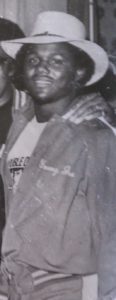Ringside Report Looks Back at Former Cruiserweight Title Challenger Eddie Taylor AKA Young Joe Louis
[AdSense-A]
 By Donald “Braveheart” Stewart
By Donald “Braveheart” Stewart
You would think that, with a nickname that hailed one of the greats that Eddie Taylor, 31-18-1, 18 KO’s, would have a biography and digital foot print the length of the longest Chicago side walk. It might surprise you if you were to hear that there was not a massive presence of memories, history and the types of revelations that would make your hairs stand up on end?
It was not a nickname to strike fear in many of his opponent though and even with someone with quite a checkered career, Sean O’Grady, who remarked that “He can call himself Young Joe Louis but he still fight, like Old Eddie Taylor.”
This is a guy who made a splash from his debut in 1975 right through to retirement in 1992. From Mississippi, he became a 50 fight veteran by the time of his retirement, having fought for world honours on no fewer than 3 occasions – in 1982, 1984 and 1990.
A cruiserweight who made that step up to world level before he stepped down. Taylor was someone who had the fortune and the misfortune, like so many floating in and around in the late 80’s, to be at his height when the sweet science was not as regulated, managed or monitored as it ought to be. He was a fighter known mainly to his US fans – we did not get to see him over here in the UK, Taylor was more of crude artist than specialist puncher. He relied heavily on that ability to brawl, but it made him a cruiserweight worthy of being given decent opportunities.
A bullish cruiserweight pugilist, the first 6 years of his professional career proved exceptionally fruitful – he never lost! By his fight in Atlantic City, in 1981, against Dave Lee Royster, he had a stunning 21-0, 13 KO record and was the mid-west champion.
In 1982, the wheels on his championship bus started to come off which began after he was in his first and only draw; against Dale Grant. Taylor was certainly in fighting fit mode, looking good and boxing well until an accidental clash of heads in only the second round led to a technical draw.
What the promoters saw, however was something else. He coulda been a contender – so they made him one.
That may have been the night the Ws stopped rolling but it meant that people got to see him and make comment upon his prowess – and lack of technical finesse.
The technical draw with Royster was hardly great preparation for his next fight – a world title fight, against Ossie Ocasio in Chicago. It would simplistic, perhaps to ask, what was his management team doing to manage his career…
In December 15th 1982 Illinois, the WBA sanctioned the cruiserweight contest between Taylor and Ocasio where a 15 round decision was not to go to Taylor. It was a brave attempt, for many his best opportunity and he fought like a man who wanted it badly but did not have had the attributes to carry off the belt.
The road to redemption was not an easy one for Taylor and in his next six fights he lost a further twice; 30% of a win return does not a champion make – does it?
Following the politics and sense of the boxing world – where did he end up next?
Another world title shot came in 1984 and despite this run up to it where he was knocked out against the exotically named Ghanaian, Prince Mama Mohammed, during that 30% winning spree, he was in the ring for the IBF version of the belt and up against Lee Roy Murphy. Murphy was in control and ahead in all score cards when the fight was stopped in the 12th round.
A 4 win run, including when he beat a former champion – Marvin Camel – in 1990 – which came after sending Camel to the floor, was a points win. It gave him yet another opportunity for a world title.
In 1990 he took on Ricky Parkey for the WBF version of the cruiserweight title. There were many who thought another win here would catapult him back into a bigger world level mix; the result was a sixth round stoppage for Parkey. The win against Camel had proved to be a very false dawn – Taylor never won again.
Taylor did fight on and the last few years saw his prowess fade, his record suffer from him being a gateway contest for fighters on their way to better things. Many of the fighters who faced him, though found their pathway closed in other ways but he was at least a decent test of their mettle.
By the end of his career in 1993 he had 18 losses on his career, 9 of them coming in his last few years as a pro. The losses were brutal and he did not cover himself in either cash or glory. One of the fighters of note on his record towards the end was future heavyweight contender, Andrew Golota but Golota was one who did flatter a little to deceive. For British fight fans he also fought fringe world titlist Henry Akinwande – who fought Lennox Lewis for the world title in 1997 – so we have a connection.
Last time we heard, Taylor was doing well and living in Chicago, perhaps not feasting off his career but at least dining well.
[si-contact-form form=’2′]

